The U.S. Border Crisis
The U.S. has been facing a surge of unaccompanied children arriving from violence-torn El Salvador, Guatemala and Honduras in recent months. A majority travel thousands of miles by road and rail through treacherous terrain to reach the U.S.–Mexico border.
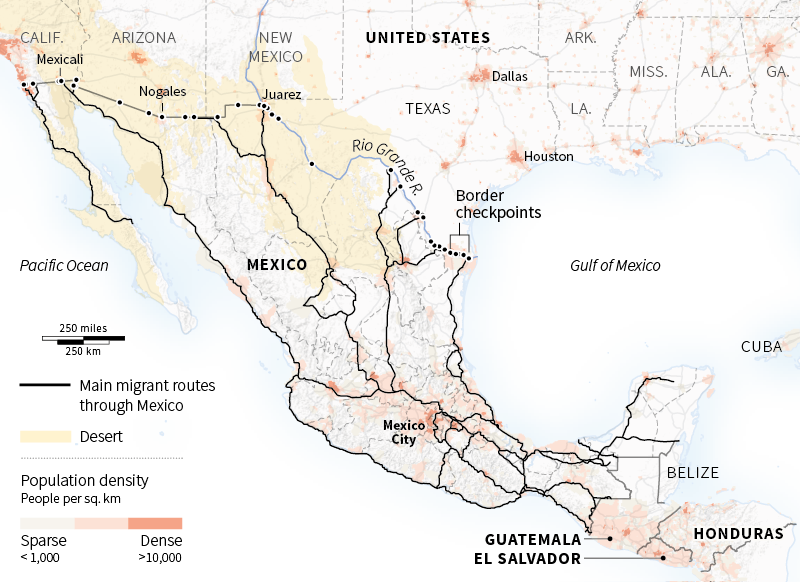
Illegal immigrant population in America
The Pew Research Center estimates that there are more than 11 million illegal immigrants living in the United States. Most of them reside in California, Texas, Florida, New York, New Jersey and Illinois.
State-level estimates
Nationwide estimates
Insufficient data = Estimates smaller than 10,000 are not shown.
Estimates for all states from Pew Research Center February 2011 "Unauthorized Immigrant Population: National and State Trends, 2010" except California, Florida, Illinois, New Jersey, New York and Texas which were updated in the September 2013 report. Pew Hispanic Center estimates based on residual methodology applied to March Supplements to the Current Population Survey for 1995-2004, 2012 and to the American Community Survey for 2005-2011. Single-year estimates are used for 2010 for Arizona, California, Colorado, Connecticut, District of Columbia, Florida, Georgia, Illinois, Maryland, Nevada, New Jersey, New York, North Carolina, Oregon, Texas, Virginia and Washington. Estimates for 2010 for the remaining 34 states are averages of 2009 and 2010.
Reuters/Ipsos poll: Attitudes toward children at the border
A majority of Americans are amenable to allowing illegal unaccompanied migrant children to stay in the United States, at least for a while, a Reuters/Ipsos poll conducted from July 31–August 5 shows.
A) As you may know, a large number of unaccompanied children from Central America are being detained at the U.S.–Mexico border after trying to cross into the United States. In your opinion, what should the federal government do in response to this situation?
B) Current law says that the United States must hold these children until it can be determined whether it is safe to return them to their country of origin. However, the facilities currently in use along the border are becoming overcrowded and the conditions are poor. During this time do you think the children should be...
C) Do you support or oppose allowing these unaccompanied immigrant children being temporarily relocated to your community?

*Non-white minorities
About the Reuters/Ipsos poll: A sample of 1,566 Americans ages 18+ were interviewed online. The survey is measured using a credibility interval and in this case, it had a credibility interval of plus or minus 2.8 percentage points. Percentages may not add up to 100 due to rounding.
Reuters/Ipsos poll: Attitudes toward immigration
As President Barack Obama considers sidestepping Congress to loosen U.S. immigration policy, a Reuters/Ipsos poll conducted from July 15–22 shows Americans are deeply worried that illegal immigration is threatening the nation's culture and economy.
A) Should the number of immigrants legally allowed to enter the country be increased, be kept at its present level, or be decreased?

B) Which of the following statements comes closer to your personal opinion?
Undocumented immigrants...

C) Which of the following statements comes closer to your personal opinion?
Undocumented immigrants...

About the Reuters/Ipsos poll: A sample of 2,014 Americans ages 18+ were interviewed online. The survey is measured using a credibility interval and in this case, it had a credibility interval of plus or minus 2.5 percentage points. Split sample size = 1,005 for B and C.
Traveling alone
Between October 2013 and July of this year, nearly 63,000 unaccompanied children (aged 0–17) have flooded across the southwestern U.S. border, double the figure from the same period the year prior. Many of them are from Honduras, El Salvador and Guatemala, where extreme poverty, gang violence and domestic abuse is prompting the children to flee.
Unaccompanied migrant children apprehensions by border patrol sector
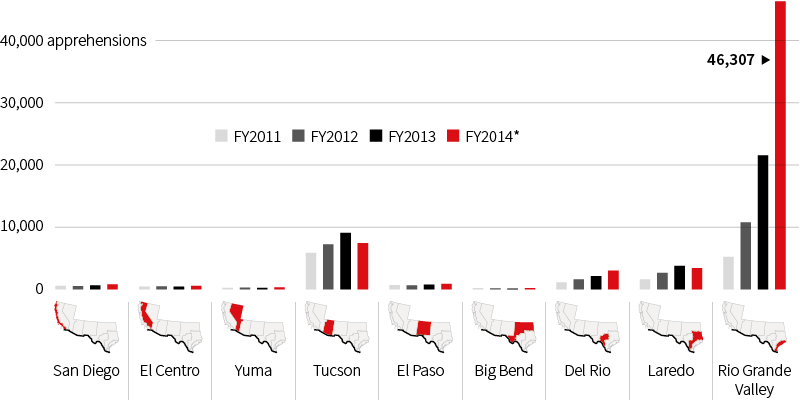
* FY2014 data through July 31, 2014.
Far from home
The map shows the number of unaccompanied children apprehended at the U.S.-Mexico border by origin (Guatemala, El Salvador, Honduras) from January 1 to May 14, 2014. Over 2,200 children, the largest number, came from San Pedro Sula, Honduras, the city with the highest murder rate in the world according to latest rankings from Mexico's Citizen Council for Public Safety and Justice.
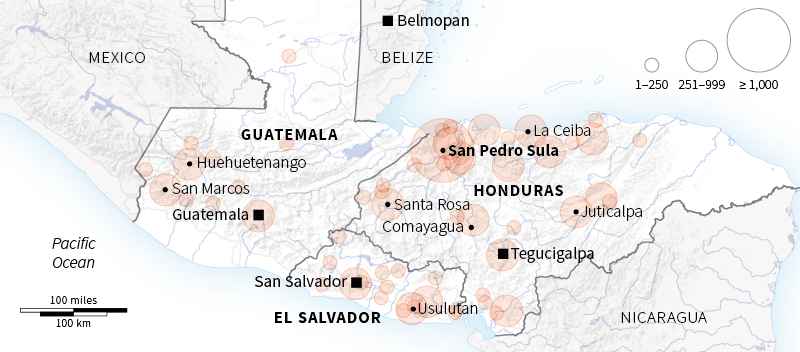
Unaccompanied migrant children apprehensions by country of origin
* Country-wide data for all years except FY2014. FY2014 data through July 31, 2014, reflects apprehensions at the southwest border only.
Caught at the border
The total number of apprehensions at the U.S.-Mexico border has risen in recent years, especially in the Rio Grande Valley sector in Texas which rose 58 percent from FY2012 to FY2013.
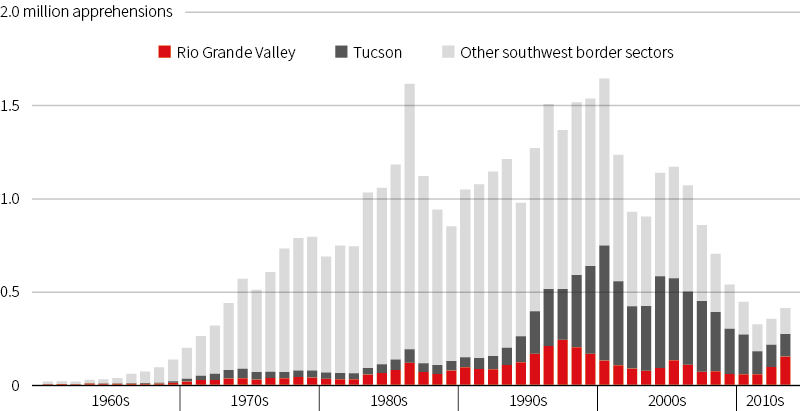
Kidnappings in Tamaulipas
In recent years, tens of thousands of Central American migrants traveling to the U.S. have been kidnapped in Tamaulipas, an oil-rich Mexican state that has long been a battleground between violent drug gangs seeking to control smuggling routes. Recent hits against the leadership of the Zetas and Gulf cartels have led lower-ranking foot-soldiers to expand into migrant kidnappings and extortion. A surge in Central American migrants caught trying to enter the U.S. via Tamaulipas this year has provided these gangs with more potential victims.
* 2014 data = January to August only.
Migrant deaths along the U.S.–Mexico border
Number of deaths by border patrol sector along the U.S.-Mexico border between FY2000 and FY2013.
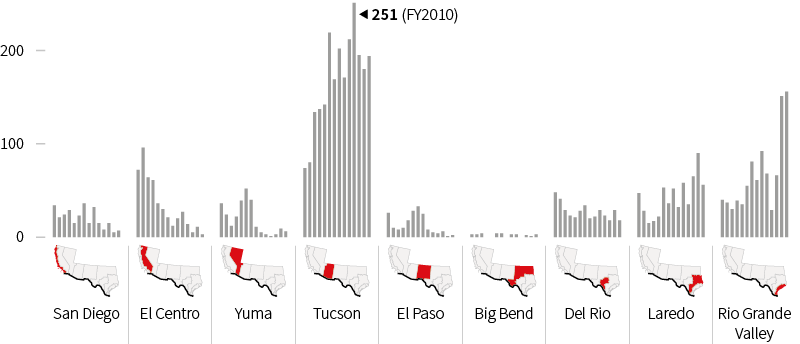
Deaths on the Arizona-Mexico border
Each red dot represents the body of an illegal migrant, recovered between January 2001 and March 2014. Border deaths have increased as enforcement policies push migrants to cross remote and dangerous terrain to enter the United States.

More than 2,100 migrants have died crossing the desert through Pima County, Arizona between January 2001 and March 2014. Pima is located within the Tucson border patrol sector and is the only border county that collects geographical data on migrant deaths.
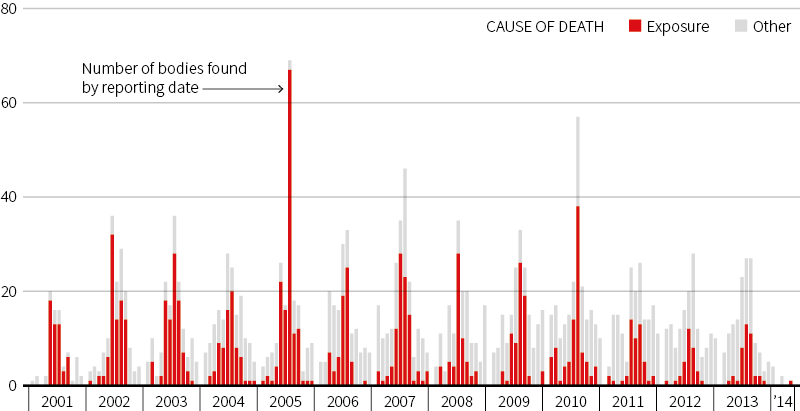
High murder rates
Honduras has the world's highest murder rate of 90.4 homicides per 100,000 people according to a recent U.N. Office on Drugs and Crime's report. The Central American country has suffered a wave of violence in recent years, as Mexican drug cartels have expanded into the country, enlisting local street gangs and using the country's often lawless Caribbean coastline as a pit stop for U.S.-bound cocaine from South America.
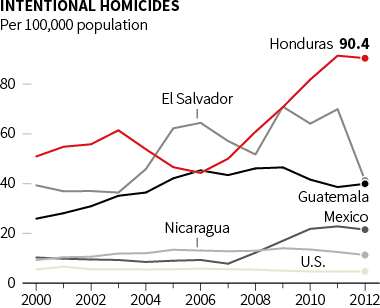
Impoverished
Honduras is one of the poorest countries in Latin America by GDP per capita and more than 66 percent of its population live below the national poverty line. Many have decided to take the arduous and dangerous journey northwards, hoping to seek work and a better life in the United States.
* Nicaragua as of 2009; El Salvador, Honduras and Mexico as of 2010; Guatemala as of 2011.
Drug–trafficking
El Salvador, Guatemala, Honduras and Mexico are among 22 major illicit drug producing and/or drug-transit countries identified by the U.S. These countries are either a significant direct source of illicit drugs and/or countries through which the drugs are transported.
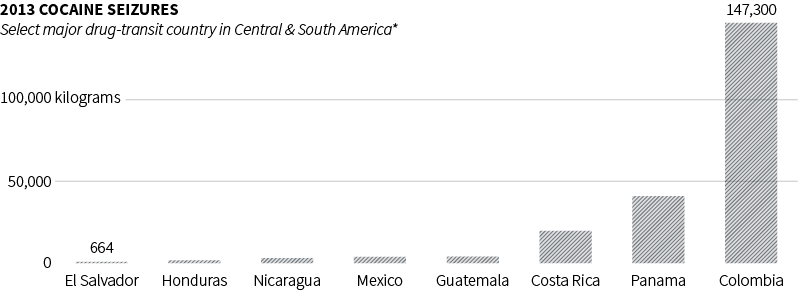
* Colombia's data includes cocaine base; Mexico = December 2012 to July 2013; El Salvador = January to October 2013.
Note: U.S. fiscal year runs from October 1 to September 30.
Sources: U.S. Customs and Border Protection; U.S. Department of Homeland Security; Office of Refugee Resettlement, U.S. Department of Health and Human Services; Congressional Research Service; SEDAC/CIESIN, Columbia University; Arizona OpenGIS Initiative for Deceased Migrants, Humane Borders; Rodolfo Casillas R.; Consejo Ciudadano para la Seguridad Publica y la Justicia Penal A.C.; United Nations Statistics Division; United Nations Office on Drugs and Crime; Pew Research Center; World Bank; Reuters; Ipsos.
Additional work by Matthew Weber